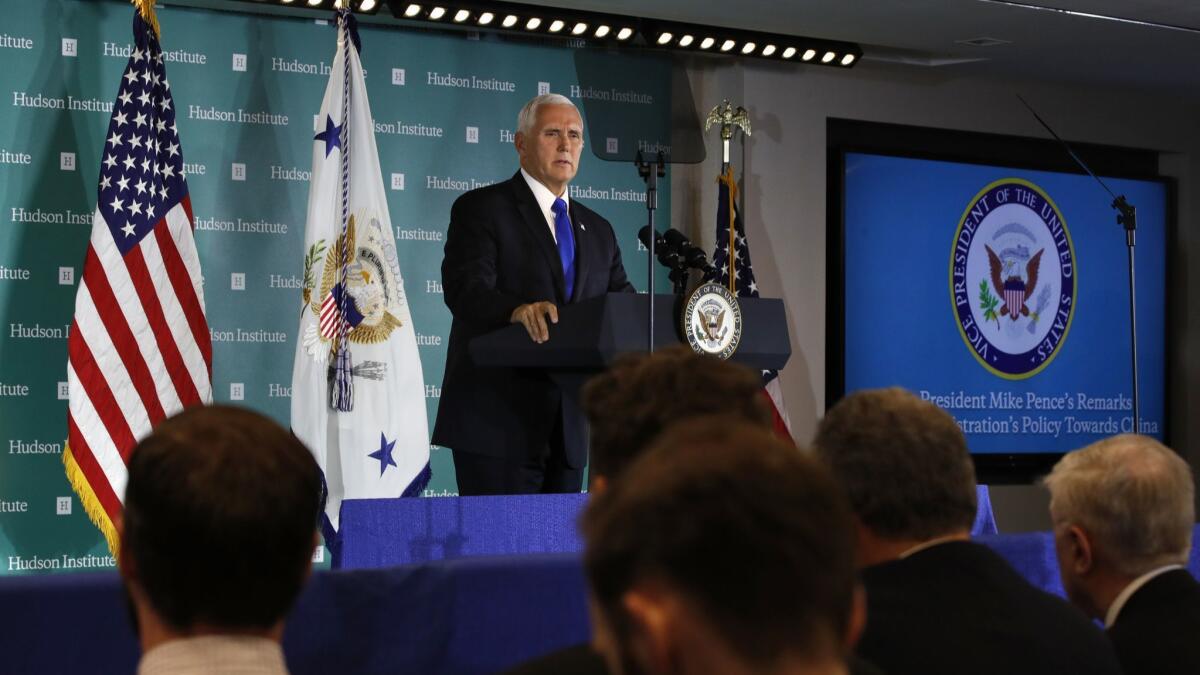Op-Ed: Trump’s trade war with China isn’t about trade, it’s about global power. The U.S. isn’t winning

- Share via
In a scathing denunciation of China last week, Vice President Mike Pence accused Beijing of using “tariffs, quotas, currency manipulation, intellectual property theft, and industrial subsidies” to rack up a colossal trade surplus with the United States. Pence promised that the Trump administration would double down on its policy of raising tariffs, which already total around $250 billion in goods.
But Pence didn’t focus solely on China’s unfair trade practices. He also charged Beijing with trying to induce American universities, think tanks, businesses, and even state and local governments, to adopt pro-China positions and accused China of flexing its muscles against Japan, militarizing the South China Sea, and ramping up repression at home.
The indictment confirmed what many have suspected — Trump’s “trade war” with China isn’t really about trade. Despite commentary that identifies the president’s primary motives as “jobs and money,” the White House is embarked on a larger effort to contain a rising China. And China’s leaders understand this full well.
Even before Pence’s speech, Beijing viewed Trump’s tariff increases alongside steps he has taken outside the economic realm. These include his recent approval of a $300-million arms sale package to Taiwan. Even though it was the second smallest such deal in over a decade, Beijing was incensed, doubtless because it followed a $1.4-billion arms package to Taiwan last year.
For Beijing, the economic pain is worth enduring to achieve its long-term goal of shifting the global balance of power.
Trump also signed a law in March authorizing high-level contacts between Taiwanese and American officials despite the fact the U.S. doesn’t formally recognize Taiwan. During a dinner with a group of American CEOs in August, Trump claimed that Chinese students in the United States serve as spies. While addressing the U.N. Security Council last month, he accused Beijing of trying to influence the midterm elections. His secretary of State, Michael R. Pompeo, publicly condemned Beijing’s repression of the Uighur people, in the Turkic-Muslim Xinjiang region. And the U.S. Navy has been challenging China’s territorial claims in East and Southeast Asia.
China’s leaders, however, aren’t backing down. The stakes are way too high. Trump’s tariff increases have been met with countermeasures, and China appears undaunted by the president’s threat to raise the tariffs to 25% by year’s end. Beijing has also ruled out trade talks, claiming that the U.S. is “holding a knife to its throat,” and for good measure, the Chinese canceled a mid-October meeting on security that Secretary of Defense James N. Mattis had been scheduled to attend.
Alongside these demonstrations of resolve, China has portrayed itself to the world as outward-looking and pro-globalization. It wants to turn Trump’s trade war to its advantage by playing on widespread fears that his protectionist trade policies will hurt all countries.
Chinese President Xi Jinping has repeatedly hailed the benefits of free trade and presented China as the responsible adult when it comes to managing the international economy. This strategy dates back at least to last year’s Asia-Pacific Economic Cooperation summit. Trump used his appearance there to encourage Asia’s leaders to turn inward; Xi called for “partnerships based on mutual trust, inclusiveness and cooperation.”
Enter the Fray: First takes on the news of the minute from L.A. Times Opinion »
Chinese officials echoed this refrain at the annual World Economic Forum in Davos, Switzerland, presenting their Belt and Road global infrastructure project as a deal designed to lift all boats. The Trump administration, by contrast, paints it as a strategic offensive, which it has sought to counter with its own $113-million aid plan for Asia — paltry compared to the $900 billion China plans to pour into the Belt and Road initiative.
China’s strategy has been paying off in increments. New polling data from the Pew Research Center show that while many countries still prefer U.S. global leadership, they also recognize China’s growing importance and that their confidence in America’s capacity to lead has declined.
China’s leaders understand that Trump’s tariffs are likely to reduce Chinese economic growth, which relies heavily on exports. But they also believe that backing down in the tariff war will only encourage the United States to turn up the pressure on other fronts, whether Taiwan, Xinjiang or the South China Sea.
For Beijing, the economic pain is worth enduring to achieve its long-term goal of shifting the global balance of power. China’s quest for primacy, and the White House’s determination to prevent the replacement of Pax Americana by Pax Sinica, means that a long, difficult U.S.-China cold war lies ahead. Pence confirmed it.
Jeffrey Kucik is an assistant professor in the School of Government and Public Policy at the University of Arizona. He maintains the trade policy site www.trademonitoronline.com. Rajan Menon is a professor of international relations at the Powell School, City College of New York/City University of New York.
Follow the Opinion section on Twitter @latimesopinion and Facebook
More to Read
A cure for the common opinion
Get thought-provoking perspectives with our weekly newsletter.
You may occasionally receive promotional content from the Los Angeles Times.









